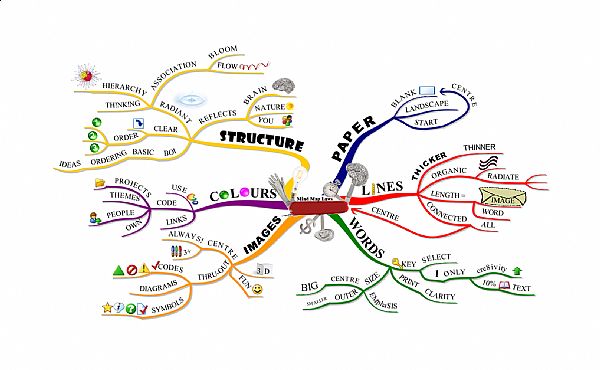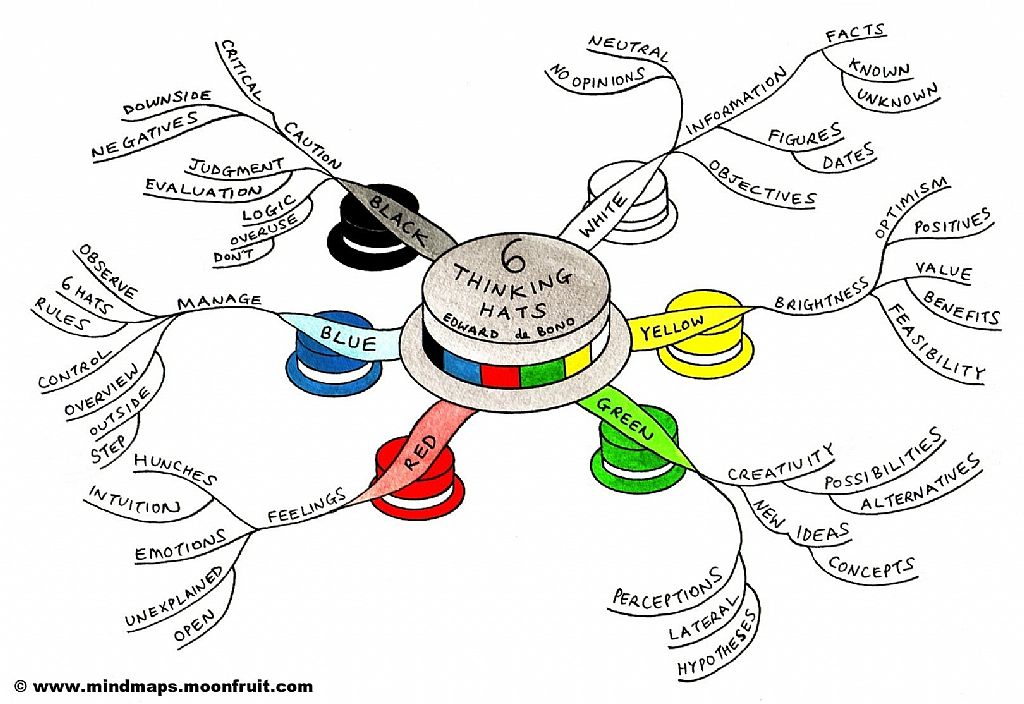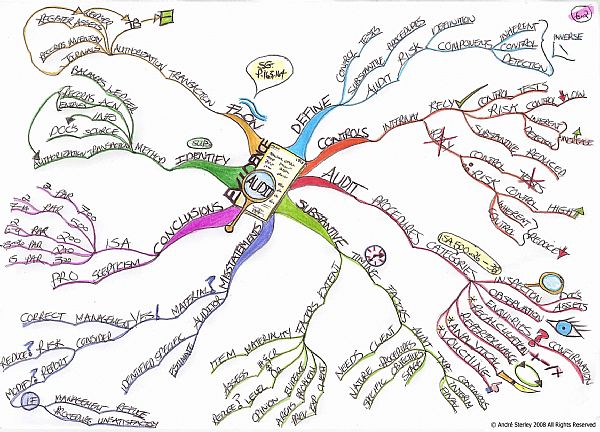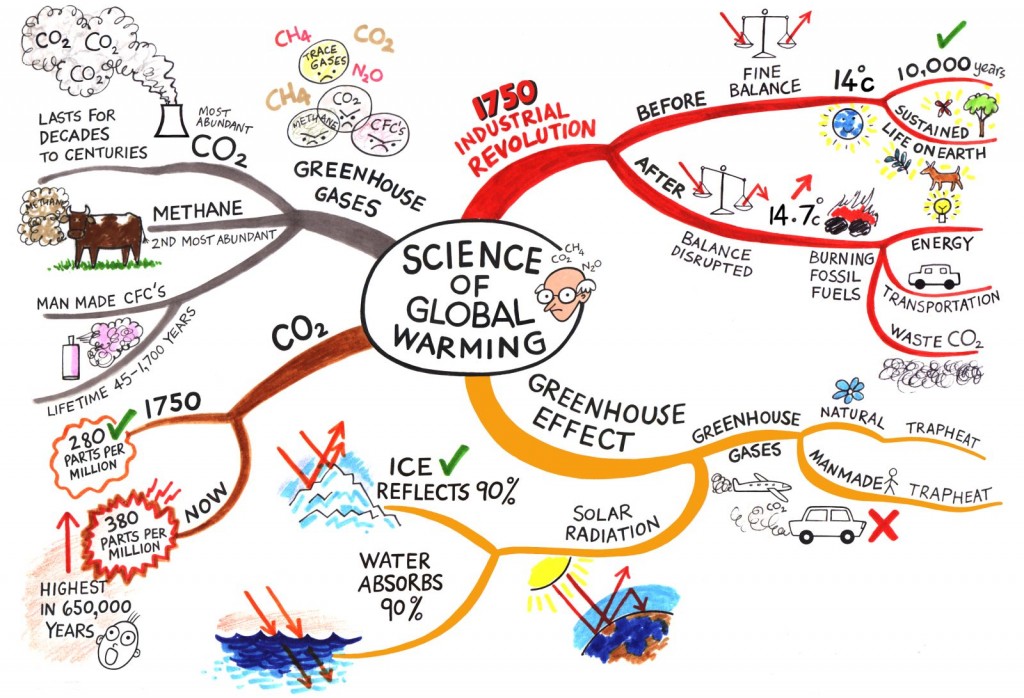Imagine going out for lunch with your friends. You stretch across the table to grab hold of the jar of oregano and conveniently drag your mane (or the strings of your fancy jacket, guys) all over the pizza. Nobody brings this to your notice, so at the end of the day you have a crispy strand of hair covered in pizza sauce sticking out of your head like weed in a mustard field.
That is exactly what it felt like studying and learning those mind-boggling things in 11th and 12th. The crispy strand of hair represents the entire collection of things we had to note down, learn or mug up. That ‘knowledge’ remained with us for a few days and then dissipated, leaving behind no evidence of having existed once. This was not helped by the fact that the cumbersome notes we took didn’t come to our rescue at the last moment. We had to read them from scratch again and again and…well you get the point.
That is when I was introduced to The MindMap Book by Tony and Barry Buzan, which immediately caught my attention when it belted out promises of ensuring my ability to retain knowledge for a duration longer than Diwali holidays.
So what exactly is a Mind Map?
![]()
![]()
![]()
![]()

![]() A Mind Map is a learning tool that enables you to form concise notes while keeping the integrity of the topic intact, saving hours and hours of mindless note making. It helps in the process of retaining notes not just for the purpose of clearing exams, but for a time much much longer than that.
A Mind Map is a learning tool that enables you to form concise notes while keeping the integrity of the topic intact, saving hours and hours of mindless note making. It helps in the process of retaining notes not just for the purpose of clearing exams, but for a time much much longer than that.
Magical? Not really. Just simple science.
Human Brain has an enormous capacity of harnessing and storing information. It is programmed to remember things through associations. Whether it is a sight, smell or a sensation, the brain has the ability to generate thousands of associations related to it. Our Memory works by this exact process. It spreads from word to a related word via links.
What a mind map does is it helps us to create these links. It increases this brainstorming ability by tapping into our creativity.
To help drive the point across, the following exercise of a ‘Mini Mind Map’ can be attempted. This is an embryonic form of the actual mind map but it does help in garnering a general idea of what a mind map can do.
Write down the word “Speed” on a blank sheet and (without pausing) jot down the first ten words that come to your mind no matter how ridiculous. Take no more than 1 minute to complete this. Now jot down new words taking one of the associations as a template. For example, Speed might have encouraged you to write the word Athlete, now using this as the central theme find new associations.
The better you get at this, the easier it will be to build new associations, more adept you will be at forming Mind Maps and easier it will become for your brain to recollect.
Making Your Own Mind Maps
Think of these Mind Maps as a Swiss Army Knife. A compact multi functional tool that aids in revision, creating concise notes, learning effectively all the while stimulating your ability to think creatively.
Despite exerting such a powerful effect on our brain, mind maps are fairly easy to create by developing a format that our brain finds easier to recall. It happens more frequently than one would like to admit, but in spite of having pages worth of notes on a topic, the overall picture remains unclear. Mind maps remove this obscurity.
This is the easiest way to go about it;
- Choose the topic you want to create a mind map about.
- Write it in the centre of an A3 or A4 size sheet. Make it as prominent as possible by using multiple colours and dimensions. Let’s just say, in this case attractiveness is proportional to attention and not distraction. A well defined image would focus your eyes and brain thereby generating numerous associations.
- Brainstorm to generate key words not sentences. The whole point of this exercise it to use as few words as possible without compromising on the content. The aim is to create a mind map equivalent to those painstakingly long and monotonous notes. It seems tough but with practice, it gets easier.
- Draw ‘branches’ from the central topic to represent the first set of divisions. Each ‘branch’ should be accompanied by the key word written on top of it. As you burrow into the topic create more and more branches for the subsequent sub divisions until you’ve covered everything you wished to cover (and then some).
These four tips are the core of this process, but the next two are essential for “personalizing” your mind map and making it more relatable for your brain;
- Use colours and images wherever possible. A balance between the visual and linguistic cortex improves perception and recollection. The saying ‘a picture is worth a thousand words’ couldn’t have a more literal interpretation and effective application.
- Develop a personal style. Keeping the general principles intact, a mind map is the product of our creative manufacturing. There is no correct or incorrect way to go about it. A ‘messy’ artistically challenged Mind Map is in no way wrong as long as it makes sense to the person who creates it.
And now that your mind map is done, here are three ways to keep them floating in your memory for as long as you need them;
- Review your mind maps. To keep mind maps in active memory, one should ideally review them a day after making it. Then after a week and then once every month.
- Do mind map checks every once in a while. This will enable you to assess your ability to recall things without any external stimulus.
- Practice “Mini Mind Maps” every now and then. Needless to say, they are the catalyst to our thinking process.
Why They Work – And Are Better Than Notes
Mind Maps tend to explore the flaws associated with standard note making and note taking.
Note-making is organizing your own thoughts, whereas note taking is summarizing someone else’s thoughts – as we do in a lecture. The standard protocol that 95% follow during note-taking is to write down everything in a linear form verbatim. Sometimes one does use a few symbols and abbreviations here and there, but the essential pattern remains the same. What this does is that it dilutes the entire learning process by distracting us with unnecessary sentences while masking the important ones.
Furthermore, the notes taken are in a single colour making the notes monotonous. Monotony bores. When the brain is bored, what does it do? It goes off to sleep. So essentially we have developed a note taking pattern that is designed to bore us and program our brain to sleep! These notes lack any visual rhythm, colour, imagination and overall association. They obscure key words and waste our time by encouraging unnecessary noting.
Mind Maps overcomes these flaws.
The natural function of the brain is to form associations to remember things. Mind maps exploit this fact and encourage Radiant Thinking i.e. the main themes of the topic radiate from the central image as branches. Each branch corresponds to a key word or a key image with topics of lesser importance represented by branches of higher level.
The complete process of generating mind maps can be equated to the 3 ‘A’’s
- Acceptance: This is the first and most essential step where one should put aside any preconception about their artistic ability and intellectual confines.
- Apply: This is the dynamic step which involves the creation of mind maps.
- Adapt: This final step involves development of mind mapping skills by experimentation and creation of a personal style.
Making Mind Maps is not rocket science but it definitely isn’t a cake walk either. The first mind map that I created took a LOT of time and patience. Being so used to writing lengthy answers and taking cumbersome notes, I found it hard to use just a few words to represent an entire paragraph or an idea. It was not till my 10th mind map that I felt comfortable in consolidating large information in a precise manner. So strain those grey cells and give it a go! Mind maps may look ridiculous to everyone else but it’s creators, and that is one of the most interesting things about it. The mind maps you create are tuned to your semi-consciousness, and you can exploit this tendency of your brain’s tendency to memorize visuals more accurately than sentences and drastically improve the amount of syllabus you can fit into your head – permanently.












